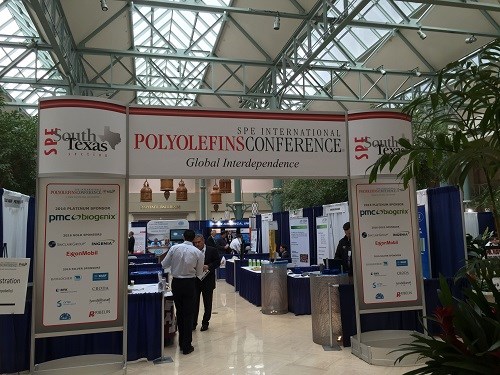Some Highlights from SPE Polyolefins 2016
This international conference featured several tracks with a broad range of topics addressed by industry and academia pros.
This international conference featured several tracks with a broad range of topics addressed by industry and academia pros.
I attended this year’s Houston-based SPE International Polyolefins Conference in late February and was impressed by the breadth of topics addressed by industry and academia as well as the number of sessions, which totaled 88. The Polyolefins 2016 event had over 620 attendees, 12 sponsors, and 64 exhibitors.
Highlights included seven plenary sessions which focused on polyolefin industry trends domestically and globally and sessions on innovations. Here are some takeaways from these sessions:
• Global PE supply/demand balance within the next five years reverses itself after five years of demand exceeding supply, according to Houston-based IHS Chemical (ihs.com). There is a looming historic overrun coming our way—expect at least two-years-worth (2016-2018) of excess PE capacity at low-cost production. Operating rates which have been over 90 percent, will drop.
• PE prices will be impacted by all this—expect prices to reach an equilibrium. While North American PE prices will take the biggest hit, expect to see a swifter move toward price parity for PE globally, ventures IHS. Through this year, PE prices could end up dropping a total of 10ȼ/lb or more.
• New North American PE entrants and those with major new capacity slated within next two years (e.g., Ineos/Sasol, Braskem, Nova) will offer some incentives to for processors to “switch suppliers and lock-up business,” projects IHS. Overall, buyers will have more leverage vs. worrying about locking-in supply.
• Addressing both PP and PE in terms of the North American supply scenario, Houston-based ICIS made the point that the two are in direct opposite trajectories—with the former tight and getting tighter and the latter long and growing longer.
• ICIS sees PP rapidly reaching full-out capacity domestically, noting that demand eclipsed production in 2015, and PP suppliers’ margins were three times what they had been in the past.
• The range of prices being paid for PP is much wider than ever before.
• PP imports are needed and will continue to be needed as the closest slated new capacity will not show up until late 2017. Major exporters are the Middle East and Southeast Asia.
• On the innovation front when attending industry conferences these days, it is rare not to hear something new about 3D Printing. Innovative Plastics and Molding (IPM), Sylvania, Ohio discussed its creation of a new 3D printing natural fiber (25% cellulose-based) in a polyolefin matrix developed to compete with PLA and ABS in the FDM prototyping and additive manufacturing process.
IPM came up with the “right polyolefin”—after trying both homopolymers and copolymers—in terms of crystallinity, heat resistance, and shear strength. Advantages cited over PLA and ABS filaments include having overcome warping and odor issues, and they have found that they can process at much higher temperature than previously thought. Parts printed so far are parts that could not be injection molded and are far closer to micromolding.
Meanwhile, tracks on advances in polyolefin stabilization & modifiers, and catalysts & process advances had top billing in terms of the number of presentations—17 and 14, respectively. Some highlights of the former track included:
• Sumitomo Chemical America, New York, N.Y. discussed high-performance processing stabilizers for enhancing LLDPE films and one for enhancing PP films. They are based on a hybrid-type antioxidant with both phosphonic and phenolic moieties. Higher heat stability, higher resistance to discoloration, and lower blooming are claimed.
• BASF discussed a permanent antistat Irgastat P for polyolefins, which is intrinsically dissipative and intrinsically conductive. It has been used in both LLDPE blown film and PP fiber applications. More recently, it had been shown to have excellent weatherability for use in outdoor PP applications.
Also discussed by BASF was non-sorbitol nucleation for PP. XT386 is a high-performance clarifier that has a positive effect on crystallization temperature and speed. Typical sorbitol clarifiers require 1500-2200 ppm use levels—an order of magnitude over XT386 clarifier, which only requires 150 ppm. Excellent thermal stability is claimed—with XT386 remaining stable up to 286 F. Recent work has found that this clarifier performs very well in gamma-irradiated PP copolymers used for medical applications. In addition, enhanced thermal stability and much less colorability is reported after irradiation.
Other interesting conference tracks, typically with an average of six presentations, included: advances in innovative reinforcements of polyolefins; applications in building & construction; advances in film & flexible packaging; and foams & high-melt strength PP.
There were also tracks on advances in characterization and properties; polyolefins and sustainability; and, recent advances in fibers & non-wovens.
Search for nearly 100,000 grades of polymers on the Universal Selector by clicking here
Search for nearly 40,000 additives on the Universal Selector by clicking here

Read Next
Troubleshooting Screw and Barrel Wear in Extrusion
Extruder screws and barrels will wear over time. If you are seeing a reduction in specific rate and higher discharge temperatures, wear is the likely culprit.
Read MorePeople 4.0 – How to Get Buy-In from Your Staff for Industry 4.0 Systems
Implementing a production monitoring system as the foundation of a ‘smart factory’ is about integrating people with new technology as much as it is about integrating machines and computers. Here are tips from a company that has gone through the process.
Read More




















